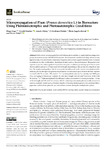Mostrar o rexistro simple do ítem
Micropropagation of Plum (Prunus domestica L.) in Bioreactors Using Photomixotrophic and Photoautotrophic Conditions
| dc.contributor.author | Gago Mesejo, Diego | |
| dc.contributor.author | Sánchez, Conchi | |
| dc.contributor.author | Aldrey Villar, Anxela | |
| dc.contributor.author | Christie, Colin Bruce | |
| dc.contributor.author | Bernal, Á. | |
| dc.contributor.author | Vidal, Nieves | |
| dc.date.accessioned | 2022-06-16T13:34:08Z | |
| dc.date.available | 2022-06-16T13:34:08Z | |
| dc.date.issued | 2022-03-29 | |
| dc.identifier.citation | Gago, D.; Sánchez, C.; Aldrey, A.; Christie, C.B.; Bernal, M.Á.; Vidal, N. Micropropagation of Plum (Prunus domestica L.) in Bioreactors Using Photomixotrophic and Photoautotrophic Conditions. Horticulturae 2022, 8, 286. https://doi.org/10.3390/horticulturae8040286 | es_ES |
| dc.identifier.issn | 2311-7524 | |
| dc.identifier.uri | http://hdl.handle.net/2183/30951 | |
| dc.description.abstract | [Abstract] In this study, we propagated two old Galician plum varieties in liquid medium using a temporary immersion system with RITA© bioreactors. Environmental variables including culture system, light intensity, CO2 enrichment, immersion frequency and sucrose supplementation were evaluated in relation to in vitro proliferation, physiological status and ex vitro performance. Bioreactors were superior to jars for culturing shoots in photomixotrophic conditions, producing up to 2 times more shoot numbers and up to 1.7 times more shoot length (depending on the genotype) using shoot clusters. The number and quality of shoots were positively influenced by the sucrose concentration in the medium, plus by the light and gaseous environment. For individual apical sections the best response occurred with 3% sucrose, 150 µmol m−2 s−1 photosynthetic photon flux density and 2000 ppm CO2, averaging 2.5 shoots per explant, 26 mm shoot length and 240 mm2 leaf area, while with 50 µmol m−2 s−1 light and ambient CO2 (400 ppm) values decreased to 1.2 shoots per explant, 14 mm of shoot length and 160 mm2 of leaf area. Shoots cultured photoautotrophically (without sucrose) were successfully rooted and acclimated despite of showing limited growth, low photosynthetic pigments, carbohydrate, phenolic and antioxidant contents during the multiplication phase. | es_ES |
| dc.description.sponsorship | This research was funded by Xunta de Galicia (Spain) (project IN607A 2021), by CYTED (P117RT0522), and by CSIC (PIE 202140E015, COOPB20584) | es_ES |
| dc.description.sponsorship | Xunta de Galicia; IN607A 2021 | es_ES |
| dc.description.sponsorship | Programa Iberoamericano de Ciencia y Tecnología para el Desarrollo (CYTED); P117RT0522 | es_ES |
| dc.description.sponsorship | Consejo Superior de Investigaciones Científicas; COOPB20584 | es_ES |
| dc.language.iso | eng | es_ES |
| dc.publisher | MDPI | es_ES |
| dc.relation.uri | https://doi.org/10.3390/horticulturae8040286 | es_ES |
| dc.rights | Atribución 4.0 Internacional | es_ES |
| dc.rights.uri | http://creativecommons.org/licenses/by/4.0/ | * |
| dc.subject | CO2 | es_ES |
| dc.subject | Liquid medium | es_ES |
| dc.subject | Local varieties | es_ES |
| dc.subject | RITA© | es_ES |
| dc.subject | Rooting | es_ES |
| dc.subject | Stress | es_ES |
| dc.subject | Sucrose | es_ES |
| dc.subject | Temporary immersion | es_ES |
| dc.title | Micropropagation of Plum (Prunus domestica L.) in Bioreactors Using Photomixotrophic and Photoautotrophic Conditions | es_ES |
| dc.type | info:eu-repo/semantics/article | es_ES |
| dc.rights.access | info:eu-repo/semantics/openAccess | es_ES |
| UDC.journalTitle | Horticulturae | es_ES |
| UDC.volume | 8 | es_ES |
| UDC.issue | 4 | es_ES |
| UDC.startPage | 286 | es_ES |
| dc.identifier.doi | 10.3390/horticulturae8040286 |






